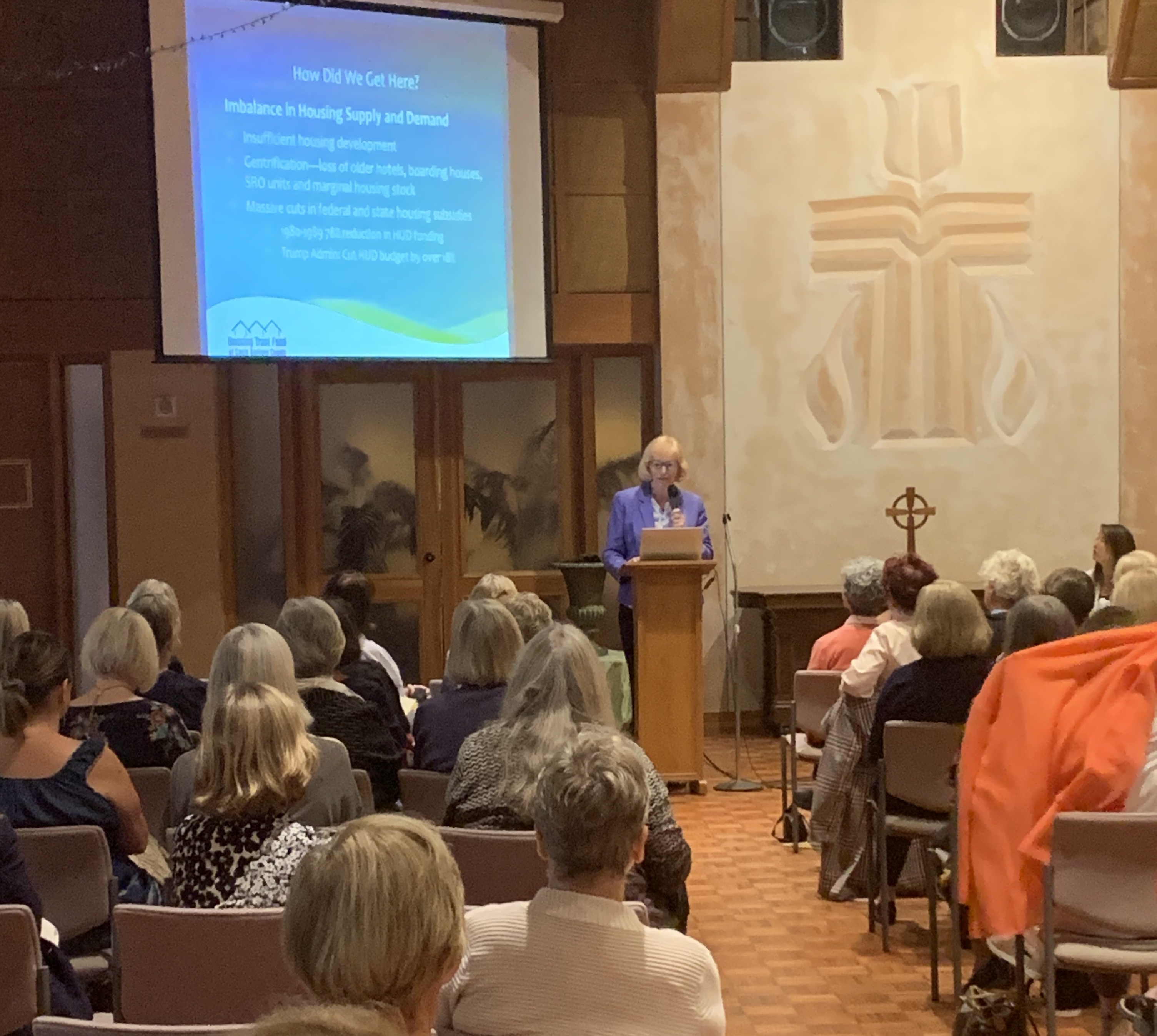
Out of California’s 58 counties, Santa Barbara ties with Orange for the second highest child poverty rate. Grim statistics show that homeless children are three to four times more likely to become homeless adults. These are among the startling facts shared by local experts on September 26 when the Women’s Fund hosted an information-packed evening entitled Homelessness and the Working Poor: Creating a Bridge to Hope.
This forum was the first of an expanded series of Grants in Action programs featuring our 2018-19 Women’s Fund grantees and the issues they are tackling. Long-time Women’s Fund member Carole MacElhenny sponsored the Grants in Action series.
More than 150 members and guests listened intently as featured speaker Jennifer McGovern (President/CEO, Housing Trust Fund of SB) spoke about the roots of homelessness, especially poverty and the lack of affordable housing.
Of single mothers in the county, 77 percent live without the ability to provide for basic household needs, including food, health care and child care. Of 46,463 families in the county living without the ability to provide for household needs, 62 percent are Latino. A “two working parent” household, earning a minimum wage of $42,000, would need a third full-time minimum wage job to achieve economic stability. In our county, a family of four needs to earn $90,000 to afford housing, food, transportation, child care and taxes.
Why is the situation so dire? Panel moderator Susan Salcido (SB County Superintendent of Schools) spoke briefly about poverty and homelessness from the perspective of our local schools before introducing the panel of Women’s Fund grantees who lead organizations working to provide solutions: Tessa Madden Storms (Regional Director, PATH), Kathleen Baushke (Executive Director, Transition House) and Brian Clark (Client Resources Regional Coordinator, Catholic Charities of SB).
McGovern noted that while CEO pay in the county has increased over 400 percent in the last 28 years, salaries for service industry restaurant workers have remained flat. In other terms, Santa Barbara residents in the top .1 percent earn 188 times as much income as the bottom 90 percent.
In 1984, the median cost of a house was four times the median family income. Today it costs 16 times as much. Santa Barbara is listed as the fifth least affordable housing market in the nation, with a rental vacancy rate below two percent.
“Housing has become an investment,” McGovern said, “not a home.” Meanwhile, as the county’s population rose from 10 million in 1950 to 19 million in 2018, existing housing stock diminished and not enough new housing was built. Today the city and county have a combined waitlist of over 19,000 households.
How do families become homeless? Job loss, a medical emergency or a personal or family trauma, such as PTSD or domestic violence, can all wreak havoc.
Speaking on the impact of homelessness in schools, Salcido said the government’s reduced or free lunch program is for children whose parents’ combined income is under $33,000. “In Carpinteria, 60 percent of students qualify,” Salcido noted. “In SB Unified, 52 percent. In Goleta, 50 percent.”
Delores Daniel, who works with underprivileged students, shared that such students may lack privacy to study at home, may not sleep well, may have no place to store their belongings, may lack fresh food, and may feel shame vis-à-vis their peers.
According to Tessa Madden Storms, PATH provides a 100-bed interim facility for the homeless coupled with “wrap-around care.” This means the organization provides health care, employment counseling, life skills and more to help prepare individuals survive and stay in their own homes.
According to Kathleen Baushke, Transition House, which owns 35 housing units, helps homeless families by insisting on sobriety, and by requiring employment and a savings account for 80 percent of all employment income, before they can transition to permanent housing. They also teach good parenting and ESL, and provide counseling for family dysfunction and lack of life skills. “Each year,” Baushke said, “70 percent of those we help are able to succeed. We follow up on them for a year.”
Brian Clark spoke about how Catholic Charities of SB helps 13,000 county-wide clients each year. “We give them clothing vouchers, provide a medical social worker, and offer food at the Haley Street Pantry. Of those we see, 92 percent live at or below the poverty level.” Clark noted that one of the most important services he provides is simply to sit and listen. “It’s a very powerful tool for building trust. But it’s stressful when you’re listening to 50 clients a day.”
One novel solution being used is voluntary relocation to other parts of California. Some organizations are experimenting with the use of “tiny houses” and 3-D printed houses but finding approved, zoned land to locate these homes is challenging. Whatever the solution, providing individuals and families with the tools they need to survive, including increased wages, runs a close second to supplying the housing itself.
“We’re all part of community and all part of the solution,” Salcido said.
The planning for this forum was spearheaded by Women’s Fund member Janis Salin and a Poverty Subcommittee including Dyan Colven, Maureen Ellenberger, Ann Lippincott, Christine Lyon and Sabina White. The Grants in Action committee overseeing all of the forums and site visits this fall includes Mary Brown, Denise Hinkle, Janis Salin and Mary Wiemann.
TO LEARN MORE:
Two new Women’s Fund reports grew out of the extensive research conducted by our Research Committee:
“2019 Research Report on the Working Poor” and
"2019 Research Report on Housing and Homelessness.”
